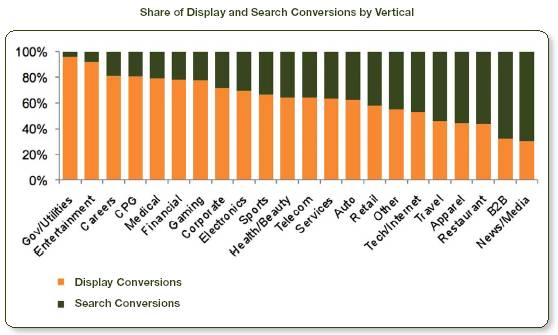Online Display and Paid Search
Many advertisers are attracted by the ability of pay-per-click search ads (aka SEM, paid search, sponsored search) to pull prospective customers to the point of purchase when that prospect is already looking for the specific product or service. Targeting these consumers makes a lot of business sense as they are closest to a purchase decision and are most likely to purchase. Also, the beauty of a pay-per-click model is that you only pay when people click through on your ad to your landing page.
Eyeblaster recently published results of a study conducted with 207 advertisers across 21 industry verticals, running cross channel paid search and display campaigns. They explain the roles of display and paid search as it relates to the purchase funnel below.
The further prospects move through the funnel, the higher the likelihood they will buy the product. Paid search works on lower parts of the funnel by targeting prospective customers in the consideration stage or in the intent to purchase stage, while display advertising potentially impacts all levels of the funnel.
Paid search advertising does not bring new prospects into the funnel, but instead, moves the existing ones through and pushes them to complete their purchase.
Since the reach of paid search ads is limited to prospects already in the funnel, it is wise to use display advertising as well. The main difference between these two tactics is that in paid search, only prospects who have typed in a designated keyword are shown the ad, while in display, the ad is served to all of the target demographic.
Also, since in paid search prospects are solicited deep in the funnel, their conversion rate tends to be high. In display, prospects may not even be in the funnel and nowhere near the purchase decision, which makes the conversion rate typically lower. It’s important to remember that display also increases awareness and retention of the brand so that prospects who are close to purchase and searching for the brand, remember the brand name to be able to search for it and get to its website.
The study reveals those advertisers that run an integrated campaign by using both paid search and display advertising receive a majority of their conversions as a direct result of display advertising. 72% of conversions where both search and display were used are directly attributed to display, and 23% directly attributed to search.
To illustrate how SEM and display work in concert with one another, Atlas Institute provided an Alltel Wireless Case Study that demonstrates the synergy between the two channels and impact on conversion rates.
The proportion of conversions generated by paid search vs. display advertising differs between verticals. Some verticals focus more on harvesting prospects already in the funnel and therefore a larger portion of their conversions come from search, while others try to expand reach and move more prospects into the funnel by using display advertising so most of their conversions come from display advertising.
 Each online channel plays a unique role in a campaign. These roles are not mutually exclusive – rather, they work together to bring advertisers the most value for their investment. Contact Applegate Media Group today so we can put together a customized online media campaign that best suits your needs.
Each online channel plays a unique role in a campaign. These roles are not mutually exclusive – rather, they work together to bring advertisers the most value for their investment. Contact Applegate Media Group today so we can put together a customized online media campaign that best suits your needs.



Friday, December 3rd 2010 at 11:33 am |
I’m not too familiar with that but guess I should be!
Thursday, April 29th 2010 at 3:03 pm |
nice to be here…. thanks for share
Tuesday, April 27th 2010 at 8:44 pm |
Thanks very good for report, I follow your blog
Tuesday, April 27th 2010 at 7:43 am |
Great article Thank
you so much!
Friday, April 23rd 2010 at 1:14 pm |
This guy is really lucky !
Thursday, April 22nd 2010 at 11:14 pm |
Thank you for your great
content.
Wednesday, April 21st 2010 at 7:23 pm |
Good share,you article very great, very usefull for us…thank you